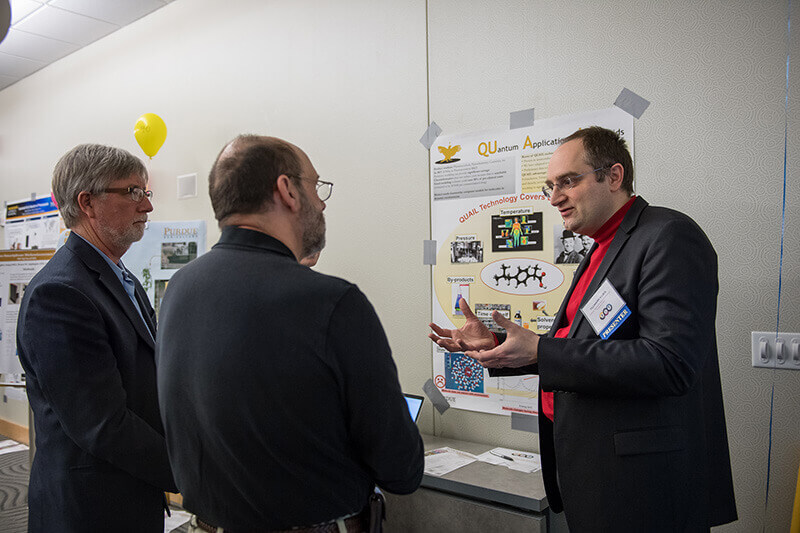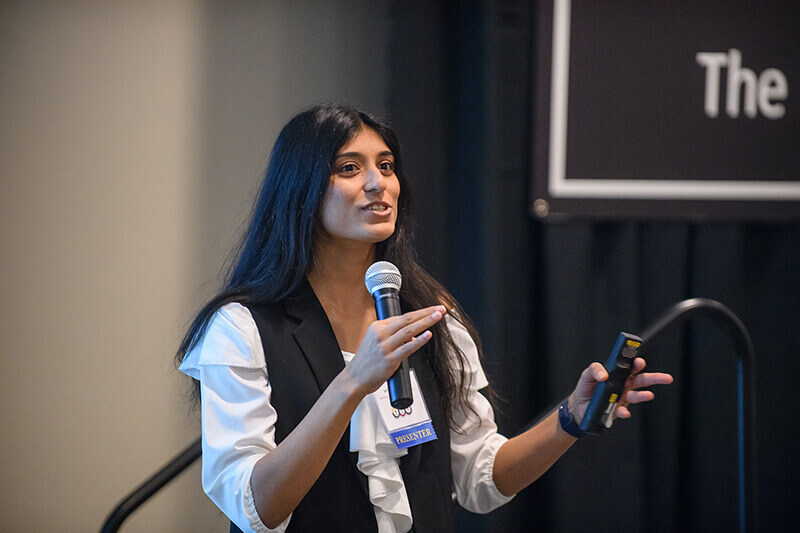Purdue, NWSC Crane researchers display top innovations available for licensing at annual technology showcase
February 25, 2018
WEST LAFAYETTE, Ind. – Purdue University and NSWC Crane researchers presented their top innovations available for licensing, including advancements in pharmaceuticals, agriculture, materials and other fields, during the second annual Purdue Technology Showcase. More than 60 business executives, investors and entrepreneurs from at least a half dozen states, including as far away as Maryland and Texas, crowded into the Herman and Heddy Kurz Purdue Technology Center on Wednesday, Feb. 21 to learn about the technologies available for licensing through the Purdue Research Foundation’s Office of Technology Commercialization. “The showcase was a huge success. The energy from the attendees and the innovators who were pitching was outstanding,” said Brooke Beier, OTC’s executive director. “Purdue innovations have the opportunity to make such an impact in the world and we hope events like this showcase continue to shine a light on these technologies and the exciting research at Purdue.” Each innovator gave a three-minute presentation during the fast-paced showcase. Links to videotaped presentations of the technologies are available below. Innovators and investors had a chance to talk more in-depth in a room where the innovators displayed more information about their technologies. “We believe valuable connections, collaborations and industry partners were identified at the event and look forward to launching technologies out of the research labs at Purdue and into the hands of those that can commercialize them,” Beier said.
Tillmann Kubis, a research assistant professor of electrical and computer engineering, talks about his research to reduce drug development costs by more accurately and efficiently modeling molecules and chemical reactions in liquid solutions. (Purdue University image/Rebecca Wilcox) Download image
Bahar Dhowan, a graduate student who works with professor Hyowon Lee in Purdue's Weldon School of Biomedical Engineering, presented an automated opioid overdose reversal implant that is placed under the skin and delivers an antidote when respiratory failure is detected.
“Once that release mechanism is triggered, it allows for the drug to diffuse out and reverse that opioid overdose effect,” Dhowan said.
Dhowan said there is a great need for the device because of the opioid epidemic facing the nation.
Jeff Miller, a professor in the Davidson School of Chemical Engineering, described during his presentationhow Purdue researchers are developing technologies converting light hydrocarbons from shale resources into transportation fuels.
“These shale formations are widely distributed around the country. There’s enough energy in these formations to last the United States at least 100 years,” Miller said. “The problem is many of these can’t be transformed into transportation fuels.”
Purdue researchers have developed a way to turn these abundant hydrocarbons and turn them into either gasoline, diesel fuel or jet fuel. The researchers believe they can develop a 15,000 barrels a day process for $200 million.
A video of the presenting innovators is linked below following their names:
- Arun Bhunia, Improved oral delivery system for drugs.
- ElizabethTopp, Improved rescue kits for people with hypoglycemia.
- Garth Simpson, Simple, inexpensive method for the detection of trace crystallinity.
 Bahar Dhowan, a graduate student who works with professor Hyowon Lee in the Weldon School of Biomedical Engineering, presents her innovation on an automated opioid overdose reversal implant that is placed under the skin and delivers the antidote when respiratory failure is detected. (Purdue University image/Rebecca Wilcox) Download image
Bahar Dhowan, a graduate student who works with professor Hyowon Lee in the Weldon School of Biomedical Engineering, presents her innovation on an automated opioid overdose reversal implant that is placed under the skin and delivers the antidote when respiratory failure is detected. (Purdue University image/Rebecca Wilcox) Download image- Davis Arrick, Improved treatment of respiratory distress syndrome. Developed in the lab of You-Yeon Won, professor in the Davidson School of Chemical Engineering.
- Hyesun Hyun, Treatment of sepsis involving molecules derived from chitosan. Developed in the lab of Yoon Yeo, associate professor in the College of Pharmacy’s Department of Industrial and Physical Pharmacy.
-
Joonyoung Park, Method to produce pharmaceutical nanocrystals comprised of more active ingredients.Developed in the lab of Yoon Yeo, associate professor in the College of Pharmacy’s Department of Industrial and Physical Pharmacy.
- JeffreyYoungblood, Cellulose nanocrystals offer alternative for high-performance, transparent coatings for plastic.
- Xianfan Xu, 3-D printer capable of printing three-dimensional structures with feature sizes as small as 100 nanometers.
- Jeff Miller, Shale resources could be transportation fuel of the future.
- Vilas Pol, Carbon cobalt hybrid shows improved rate performance, cycling stability.
- Vilas Pol, Oil-free solid lubricant improves friction, wear reduction.
- Ken Sandhage, Robust high-temperature composites for manufacturing.
- Alexander Wei, Ratio nanopores could enable smart films with sensing, actuating functions.
- David Bahr, Antimicrobial treatment to protect food processed on hard surfaces.
- Yung-Hsiang Lu, Improved identification of cameras on the internet.
- Howell Li, Cloud-based traffic program could reduce accidents, improve traffic flow. Developed in the lab of Darcy Bullock, the Lyles Family Professor of Civil Engineering and director of the Joint Transportation Research Program.
- Tillmann Kubis, Reduce drug development costs, expedite drug development.
- Mohammad Jahanshahi, Remote imaging could detect cracks, failures in infrastructures.
- Tiago Sobreira, Novel spectrometry shows rapid analyzing of complex samples. This technology was developed in the R. Graham Cooks, the Henry B. Hass Distinguished Professor of Chemistry.
- John Schneider, Rope climbing machine for standard height rooms.
- Matt Kay, Protecting microelectronic integrity.
- John Schneider, Solar, wind power management systems.
- Paul Wenthold, Kit provides analysis of wood-tar creosote.
- Prasoon Diwakar, Minimally invasive method to treat cancer.
- Jeff Rhoads, On-site diagnosis of traumatic brain injury.
- Logan Readnour. Engineered proteins could expand synthetic biology toolbox. Developed in the lab of Kevin Solomon, assistant professor of agricultural and biological engineering.
- Bahar Dhowan, Implantable single-use drug delivery for opioid overdose. Developed in lab of Hyowon Lee, assistant professor of biomedical engineering.
- Craig Goergen, Wearable biometric device shown to predict and prevent preeclampsia.
- Craig Goergen, Enhanced imaging of plaque in vascular disease, treatment.
- Jian Jin, 3-D imaging technology allows realistic prints of 3-D scientific objects.
- Richard Van Rijn, New simultaneous treatment for alcohol use and psychiatric disorders.
- Euiwon Bae, Smartphone technology may provide on-site analysis for inspection and safety.
- Marisol Pantoja, Crop moisture meter could improve crop quality, track foodborne diseases. Technology developed by Klein Ileleji, an associate professor of agricultural and biological engineering.
- * Mike Scharf, Eco-friendly method to control termites and treat fungal infections.
- * George Nnanna, Smartphone device to monitor chemical pollutants in water.
- * Reynaldo Barreto, Removing chemical contaminants in public water systems.

